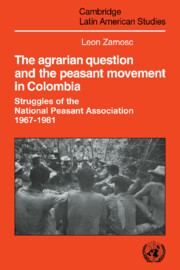 The Agrarian Question and the Peasant Movement in Colombia
The Agrarian Question and the Peasant Movement in Colombia Book contents
- Frontmatter
- Contents
- List of tables, figures, and maps
- Foreword by Tedor Shanin
- Foreword by UNRISD
- Acknowledgments
- List of abbreviations
- Map 1 Republic of Colombia
- Introduction
- 1 The agrarian question in Colombia
- 2 Reformism and the beginnings of the peasant movement
- 3 The radicalization of ANUC and the great waves of land invasions
- 4 Counterreform
- 5 The contradictory influences of peasant politicization
- 6 Concessions and repressive escalation
- 7 The new occupational alternatives and the issue of the rural proletariat
- 8 Partial repeasantization and the question of the new peasant settlements
- 9 Final crisis and clientelist regression of ANUC
- 10 Overview and final remarks
- Notes
- Bibliography
- Index
- Cambridge Latin American Studies
3 - The radicalization of ANUC and the great waves of land invasions
Published online by Cambridge University Press: 10 October 2009
- Frontmatter
- Contents
- List of tables, figures, and maps
- Foreword by Tedor Shanin
- Foreword by UNRISD
- Acknowledgments
- List of abbreviations
- Map 1 Republic of Colombia
- Introduction
- 1 The agrarian question in Colombia
- 2 Reformism and the beginnings of the peasant movement
- 3 The radicalization of ANUC and the great waves of land invasions
- 4 Counterreform
- 5 The contradictory influences of peasant politicization
- 6 Concessions and repressive escalation
- 7 The new occupational alternatives and the issue of the rural proletariat
- 8 Partial repeasantization and the question of the new peasant settlements
- 9 Final crisis and clientelist regression of ANUC
- 10 Overview and final remarks
- Notes
- Bibliography
- Index
- Cambridge Latin American Studies
Summary
ANUC had emerged with a national scope and great organizational sophistication. The movement was also highly representative, not only because it was composed of real peasants but also because it expressed various types of contradictions that affected the peasantry throughout the country. Favorable conditions had been created for the exertion of effective pressure, and the actual form and content of such pressure depended upon the future course of state policies. With the end of the Lleras Restrepo administration, the vacillations of the new Conservative government would come as a sign that reformism and the underlying class alignments were being undermined. After reviewing the events involved in the downfall of the reformist alliance and ANUC's radicalization, this chapter will examine the subsequent development of the agrarian struggles and their effects upon the evolution of the peasant movement.
The land question as the focus of peasant confrontation
Because of the precedents set in the 1960s, and also because of the direction that the Lleras Restrepo administration wanted the peasant movement to take, land redistribution was firmly established, from the outset, as the central concern of the usuarios. During the promotion campaign, special attention was paid to the regions of high land concentration, and priority was given to those places where peasant unrest was more conspicuous. It was precisely in these areas that the message of the DOC field promoters proved to be more influential.
- Type
- Chapter
- Information
- The Agrarian Question and the Peasant Movement in ColombiaStruggles of the National Peasant Association, 1967–1981, pp. 66 - 96Publisher: Cambridge University PressPrint publication year: 1986


